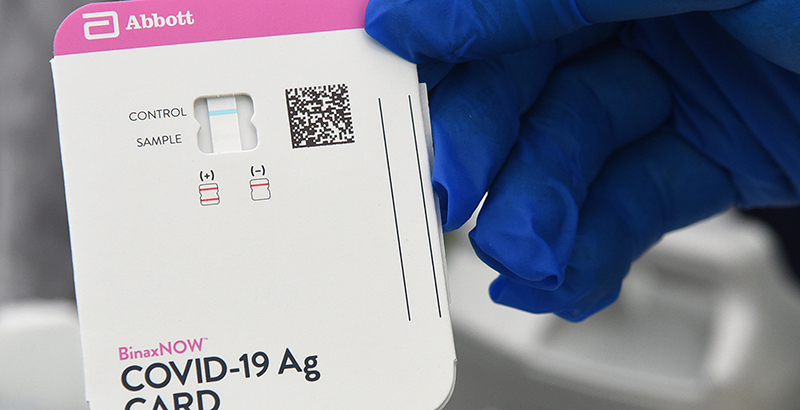Ramirez & Buher: The Path to Universal COVID-19 Testing in Schools — What the Government and States Can Do Now in Preparation for the 2021 Surge

Despite the availability of new COVID-19 tests that are faster and more cost-effective, significant barriers to universal testing in schools remain.
To date, the absence of quality COVID-19 tests has forced superintendents and principals to rely on a combination of masking, screening for symptoms, social distancing and good hygiene practices. Although testing has always been part of the theoretical construct to safely return to in-person instruction, testing staff and students at frequent intervals is currently unrealistic.
Over the spring and summer, as districts and schools developed reopening plans, they found COVID-19 tests expensive, slow, unreliable and operationally complex to implement.
For instance, the average cost of a PCR test that detects active COVID-19 infection is $100, while research has demonstrated that the false positive rate of those tests is between 2 and 33 percent. And while the average wait time for receiving COVID-19 test results has decreased since the spring, according to a recent analysis, it is often still too slow to successfully perform contact tracing.
It’s thus no surprise that the Centers for Disease Control and Prevention, the American Academy of Pediatrics, the National Academies of Sciences, Engineering, and Medicine and state officials had offered minimal advice on universal testing in schools.
That changed with the Food and Drug Administration’s approval of the Abbott BinaxNow $5 rapid antigen tests, which produce results in 15 minutes, and the subsequent decision by the U.S. Department of Health and Human Services to send 150 million of those tests to states to use at their discretion. This prompted the CDC to provide a framework for testing strategies in schools in late October.
FDA’s approval of the rapid test is only one piece of the puzzle, however. Schools still do not currently have the resources or capacity to implement universal COVID-19 testing.
From an access perspective, 150 million rapid tests won’t get us very far, even if governors allocated all those tests to schools. A recent report from the Rockefeller Foundation suggests that we need 175 million tests per month to test staff and students twice a week for adequate surveillance. This analysis assumes that Abbott, and others, can supply this number of monthly tests (they currently can’t). But for argument’s sake, if we began national implementation of this suggested testing protocol in December, with six months of the school year remaining, the price tag would total over $1 billion. With Congress failing to act on the second round of COVID-19 relief funds and local budgets decimated by the pandemic, where is the money for rapid tests going to come from?
These resource constraints are just the tip of the iceberg. Below the surface, there’s a complex set of systems issues that haven’t been adequately addressed. For example, schools need to design and implement processes to manage parental authorization for testing that meets privacy laws, capture testing data and securely manage it, and identify personnel to administer the tests — all of which present significant logistical challenges for overstretched district and school leaders. They also need dependable health and safety protocols in place to handle positive tests and the complex chain reaction of events that follow.
For all these reasons, universal rapid testing at scale is unlikely this school year.
But, universal rapid testing combined with masking, screening for symptoms, social distancing and good hygiene practices remains a critical path to a safe and full return to in-person school. While the news from Pfizer about the efficacy of its vaccine is promising, data on effectiveness in children remains to be seen, rollout will take time and overcoming vaccine hesitancy will be a significant hurdle. As a result, rapid testing will remain an important intervention for the foreseeable future.
The federal government’s leadership on COVID-19 relative to schools would certainly change with a Biden administration, but in the near term, states must lead on school-based testing issues and should consider the following:
- Reallocating education and public health budgets to purchase rapid tests (or prioritize funding in the second round of federal stimulus, should it become available).
- Streamlining procurement systems and purchasing rapid tests on behalf of districts to overcome divergent, slow and complicated processes to create a framework for equitable and efficient distribution.
- Updating reopening guidance to standardize rapid testing protocols, specifically focusing on who will be tested and how often, where testing should take place, who should administer the tests and what the isolation and contact tracing protocols should be as a result.
- Training local public health departments to support schools on those new rapid test protocols.
- Establishing a statewide database that tracks, in real time, what rapid testing protocols are being used, with standardized reporting of infection and community spread data to better understand what role, if any, schools have in driving transmission.
As the last seven months have proven, implementing COVID-19 testing at scale is incredibly hard. The unique challenges that schools will face in this effort make it all the more difficult. To turn the promise of rapid testing into the reality of a full return to in-person instruction, we must commit the necessary resources now.
Mario Ramirez, an emergency medicine physician, served as acting director for pandemic and emerging threats at the U.S. Department of Health and Human Services. He is managing director of Opportunity Labs, a non-profit consultancy and product design firm, and a senior fellow at FutureEd at Georgetown University. Andrew Buher is the founder of Opportunity Labs, a former chief operating officer of the New York City Department of Education and a senior fellow at FutureEd at Georgetown University.
Get stories like these delivered straight to your inbox. Sign up for The 74 Newsletter

;)

